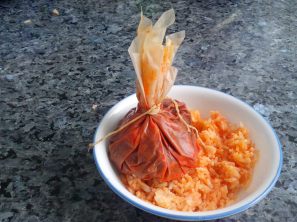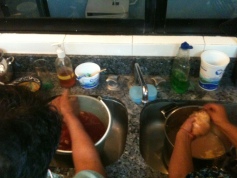I began my second quarter century on this rock on March 30, and on Saturday the 29th we had a party at my house here in Puebla to celebrate (besides my birthday we were also belatedly celebrating both my brother’s graduation from college back in summer 2012 and my January graduation from law school). We had family, longtime friends, and people we’ve become close to more recently attend, and it was a blast. We also prepared one of my favorite dishes of any cuisine ever: the mixiote.
Mixiote (pronounced meesh-EEOH-teh) is a word in Nahuatl (NAH-ooah-tl), the language of the Mexica people more commonly known by their Spanish name: the Aztecs. As a side note, the word “Mexico” comes from the word “Mexica”, which explains the country’s name. In any case, variations on Nahuatl are still spoken by 1.45 million people in Mexico according to a 2005 report of the Instituto Nacional de Estadistica y Geografia (“INEGI”), the Mexican government’s statistics bureau. Many words in English are originally Nahuatl, including avocado (aguacate in Spanish, ahuacatl in Nahuatl), chili peppers (chile in Spanish, chilli in Nahuatl), chocolate (chocolate in Spanish, chocolatl in Nahuatl), coyote (coyote in Spanish, coyotl in Nahuatl), and many more. Culturally, most Mexicans use words derived from Nahuatl every day, often without even knowing that is where they come from. Ethnically, almost all Mexicans are mestizos—of mixed European and indigenous bloodlines—with many of us from the Valley of Mexico having Mexica ancestry. Personally I’m unsure if I have Mexica blood, but my family has Zapotec and other indigenous groups in our ethnic mix.
I’ll lay out the recipe we use below, but in short the mixiote is a piece of lamb (usually), chicken, or rabbit that is put into a small bag made of the outer film of the leaf of the maguey plant and steamed or baked. Traditionally this is done in a pit, but a charcoal fired grill with a large steamer pot works just as well. In addition to the meat, laurel leaves, avocado leaves, and a sauce made of a number of different chiles and spices (but without tomato) are added to the inside of the bag so that the meat absorbs the flavors. It’s allowed to marinate overnight, and then cooked for four to six hours (and sometimes even longer if it’s lamb). It’s served with red fried rice, charro beans, and nothing else.
First, the ingredients. Fair warning—to make this, you’ll need access to some pretty diverse spices and chiles, not to mention the film of the leaf of the maguey plant. This means that you probably can’t make this exactly right in say, the Midwest of the United States (except maybe in Chicago), but I’ll mention what can be substituted for those possibly harder to find ingredients.
You’ll need:
1-2 pieces of chicken, lamb, or rabbit per mixiote
1 dried laurel leaf per mixiote
1 dried avocado leaf per mixiote
Enough film from the leaf of the maguey to wrap the mixiotes
The spices (which we’ll get into below)
The first thing you do is take your meat, whatever it may be, and “wash” it in salt. To do that, you take regular table salt (or any variation thereof) and rub it into the meat. The purpose of this is to remove the blood from the meat. Once the meat is rubbed with salt, rinse it out, squeezing the salt, the water, and blood out completely. Failing to perform this step results in the blood of the animal being cooked with your spices, which changes the flavor completely.
At the same time, you have to have cut and flatten the film from the maguey leaf (this film is actually the mixiote; while the whole dish is called that, it’s because of this ingredient) . It usually comes in long strips, each about half a foot across. You need to cut it into the desired size to wrap your mixiotes. Then you have to flatten it out with your hands (no need to take this overboard, just make it manageably flat). It has to be moist, so if you bought it dried, you can just put it in water and it will regain its natural form. If you have any left over, just put it out to dry, and when it is, fold it and store it in a plastic bag. If you can’t find the film of the maguey plant’s leaf, then you have a series of options. Some people use aluminum foil or wax paper to wrap the meat, while banana leaves can also be used (that is more typical of tropical parts of Mexico as opposed to the arid regions of the Valley of Mexico I am in).
Before you can begin building your mixiote, however, you have to have the paste of spices. The woman who taught my mother and I how to make them indirectly refused to give us her family recipe, but generally it contains a certain set of spices. You will need plenty of guajillo chiles (which is the most prevalent flavor in the final paste) to begin with. It usually comes dried, and that’s how you want them. You’ll also want pasilla chiles. The balance between the two is entirely up to personal taste. You will eventually be grinding these chiles along with other ingredients into a paste. Before doing so, however, it is essential to open them up and remove the seeds. The seeds are always the spiciest part of a chile, and the mixiote is not supposed to be spicy. Just flavorful. Once the seeds are removed, you put the chiles in water to soak until they absorb some liquid. Some people use other chiles, but the guajillo and pasilla chiles are what I’ve usually had.
Besides the two main ingredients, you need cloves, cumin, marjoram, garlic, onion, thyme, and salt to taste for the paste. You take all of these spices and grind them into a pulp. In Mexico they would be taken to a mill and ground, but at home you can do it in a mortar and pestle, or simply blend them. After blending/grinding, fry the paste in a little vegetable oil to give it a tad bit more flavor (traditionally they would have used lard, but we don’t do that).
Once your paste is ready, you mix it with the raw, washed meat and let it marinate in a pot for at least a few hours, preferably overnight (remember, do not cook anything yet). Once that’s done you take each of the pieces of the film of the maguey leaf and put one to two pieces of meat in it, with plenty of the chile paste. You add one avocado leaf and one laurel leaf (sometimes called a bay leaf) to each mixiote. It’s possible to just blend the dried avocado leaf with the rest of the spices when you make the paste. You then tie the sides of the film of the maguey leaf together with string (literally), and place into a steamer pot. As a side note, it’s not an appliance in Mexico—it’s just a pot where you put water at the bottom, and then a metal sheet with holes in it on which you put the food to be steamed. The mixiotes should cook for 4-6 hours (the chicken ones may need less, the lamb ones more).
To serve it, just put it on a plate with red fried rice. You can also have charro beans in a separate plate or bowl, but it’s not necessary. A good mixiote is a meal all by itself!





